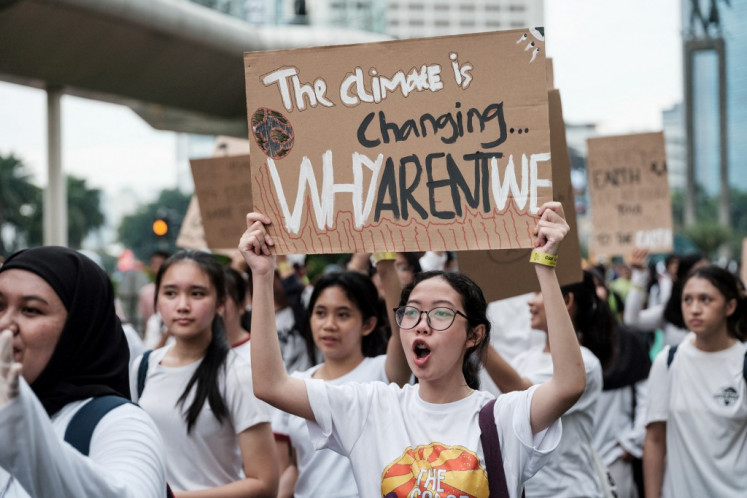Construction of elevated toll road sparks criticism
Construction of an elevated inner-city toll road that aims to alleviate traffic and ease access to Tanjung Priok Port in North Jakarta has been met with cries of dismay over fears of environmental damage and worsening traffic congestion
Change Size

C
span>Construction of an elevated inner-city toll road that aims to alleviate traffic and ease access to Tanjung Priok Port in North Jakarta has been met with cries of dismay over fears of environmental damage and worsening traffic congestion.
The central government, through the Public Works and Housing Ministry, kicked off construction of the 9.67 kilometer-long toll road, called Harbor toll road II, on Oct. 4.
Indonesia Toll Road Authority (BPJT) head Danang Parikesit said the ministry had approved the expansion of Wiyoto Wiyono toll road on Aug. 26, making way for the construction of Harbor toll toad II.
The elevated road will expand the capacity of inner city toll roads to Tanjung Priok toll road, which is connected to and is a part of the Jakarta Outer Ring Road toll section.
“With the development of the toll road, we can expect that the traffic flow from the east to the north and west [of Jakarta] will be smoother so that it will alleviate traffic and direct access to Tanjung Priok Port,” Danang said in a statement recently.
“Moreover, once the road is operational, it will also increase the competitiveness of industrial zones.”
The toll road is developed by consortia PT Citra Marga Nusaphala Persada (CMNP) and publicly listed state-owned construction firm PT Wijaya Karya and private firm PT Girder Indonesia are tasked with carrying out the construction.
PT CMNP adviser Jusuf Hamka said the Harbor road II investment scheme came from the company’s internal funding, bank loans and global bonds.
“The funding of this toll road is purely from the private sector without funds from the government. This [company] is the only one that has done so,” Jusuf said.
The new toll road is expected to be completed in 2022 with two interchange spots, in Ancol Timur and Pluit in North Jakarta, with up to six lanes built atop the existing Jakarta Inner Ring Road toll section in North Jakarta.
Urbanists, however, have lambasted the project, arguing that new toll road would not be the answer to Jakarta’s severe traffic congestion and would instead add to persistent environmental problems.
“I think the Harbor Toll Road II could potentially create more problems for the environment,” Adriansyah Yasin Sulaeman of the Greater Jakarta Transportation Discussion Forum (FDTJ) told The Jakarta Post on Friday.
Developing new toll roads will only increase air pollution, he said, adding that the roads would only be used by cars and trucks, thus encouraging the use of private vehicles. People who do not own their own vehicles, he added, would not gain any benefits but instead disadvantages from the toll road.
Adriansyah cited the induced demand theory, which states that building more roads does not reduce traffic congestion.
“Building more roads would only push more people to buy more cars, and in the end contributes to congestion,” Adriansyah said.
He said that the existing toll had already contributed to pollution, especially in North Jakarta, which is infamous for its dry and hot coastal weather. He expressed concerns that that the development would also disrupt the historical connection between Jakarta’s Kota Tua heritage area in West Jakarta and historic Sunda Kelapa Harbor in North Jakarta, in which the municipality suffers the worst of land subsidence.
“In other countries this is avoided by building tunnels, although that is pricier. What’s the urgency for Jakarta to build another elevated tool road anyway? ” Adriansyah said.
Research by the Bandung Institute of Technology (ITB) into land subsidence from 1925 to 2015 showed that significant land subsidence in Jakarta began in 1975, with North Jakarta as the worst affected area.
Land in Marunda and Cilincing had sunk 1.5 meters by 2015. Kelapa Gading has reportedly sunk by up to 2.4 m, while the worst affected area, Pluit, has sunk up to 4 m.
Air pollution has also been an issue plaguing the city, with North Jakarta home to several industries. The massive construction is feared to worsen the air quality in that part of the city. Jakarta is among cities with the worst air quality, according to the AirVisual Air Quality Index (AQI).
Adriansyah also said North Jakarta was also still lacking in terms of public transportation service compared to other municipalities, so building a new road there showed that the government had only considered car owners.
Elisa Sutanudjaja of the Rujak Center of Urban Studies said that the midst of a climate crisis and air pollution in the city, building more toll roads in the middle of the city was an outdated plan.
“The project is unnecessary and will only worsen Jakarta’s condition and mobility,” Elisa said.
She also questioned the project, which she claimed was not included in Jakarta’s spatial planning. Elisa said the Jakarta administration should reject the project because of it impacts.
Of the 44 toll roads in the country, the four with the heaviest traffic are in Greater Jakarta.









